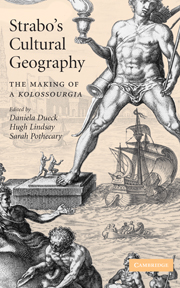Book contents
- Frontmatter
- Contents
- List of maps
- List of illustrations
- List of tables
- List of figures
- List of contributors
- Acknowledgements
- List of abbreviations
- Introduction
- 1 Kolossourgia. ‘A colossal statue of a work’
- 2 Reflections of philosophy: Strabo and geographical sources
- 3 Who is a barbarian? The barbarians in the ethnological and cultural taxonomies of Strabo
- 4 Gender at the crossroads of empire: locating women in Strabo's Geography
- 5 Strabo and Homer: a chapter in cultural history
- 6 Strabo's use of poetry
- 7 Strabo's sources in the light of a tale
- 8 The foundation of Greek colonies and their main features in Strabo: a portrayal lacking homogeneity?
- 9 Ανδρες ἔνδοξοι or ‘men of high reputation’ in Strabo's Geography
- 10 Comparing Strabo with Pausanias: Greece in context vs. Greece in depth
- 11 The European provinces: Strabo as evidence
- 12 Amasya and Strabo's patria in Pontus
- 13 Cappadocia through Strabo's eyes
- 14 Greek geography and Roman empire: the transformation of tradition in Strabo's Euxine
- 15 Josephus' hidden dialogue with Strabo
- 16 Temporal layers within Strabo's description of Coele Syria, Phoenicia and Judaea
- Bibliography
- Index of geographical names
- Index of personal names
Introduction
Published online by Cambridge University Press: 18 December 2009
- Frontmatter
- Contents
- List of maps
- List of illustrations
- List of tables
- List of figures
- List of contributors
- Acknowledgements
- List of abbreviations
- Introduction
- 1 Kolossourgia. ‘A colossal statue of a work’
- 2 Reflections of philosophy: Strabo and geographical sources
- 3 Who is a barbarian? The barbarians in the ethnological and cultural taxonomies of Strabo
- 4 Gender at the crossroads of empire: locating women in Strabo's Geography
- 5 Strabo and Homer: a chapter in cultural history
- 6 Strabo's use of poetry
- 7 Strabo's sources in the light of a tale
- 8 The foundation of Greek colonies and their main features in Strabo: a portrayal lacking homogeneity?
- 9 Ανδρες ἔνδοξοι or ‘men of high reputation’ in Strabo's Geography
- 10 Comparing Strabo with Pausanias: Greece in context vs. Greece in depth
- 11 The European provinces: Strabo as evidence
- 12 Amasya and Strabo's patria in Pontus
- 13 Cappadocia through Strabo's eyes
- 14 Greek geography and Roman empire: the transformation of tradition in Strabo's Euxine
- 15 Josephus' hidden dialogue with Strabo
- 16 Temporal layers within Strabo's description of Coele Syria, Phoenicia and Judaea
- Bibliography
- Index of geographical names
- Index of personal names
Summary
We do not know much about Strabo of Amasia. In his extant voluminous Geography, he is reluctant to surrender details regarding his personal life, even basic information such as his full name and his residential abode as an adult. Nevertheless, there is a generally accepted outline of the man's profile.
Strabo was born in Amasia, Pontus, in about 64 bce. He received a traditional Hellenistic education from the best Asian teachers at the time. As a young adult he accompanied Aelius Gallus, the Roman governor of Egypt, on his mission and later spent some years in Rome. During his earlier career Strabo composed a historiographical work now mostly lost, which was intended to survey world events as a sequel to Polybius' History. Later he concentrated on the massive endeavour of describing the entire oikoumene, producing the seventeen-book work we hold now as the Geography. He died sometime after 23 ce.
Strabo refers to his Geography as a kolossourgia, a ‘kolossos of a work’ (1.1.23). A kolossos is a statue of huge proportions and the point of the comparison, as Strabo tells us, is scale. Just as a colossal statue produces in the mind of the observer an overall impression that does not depend on a detailed representation in all its parts, so Strabo intends his Geography to represent the world as a whole, rather than individual regions in microcosm.
When and where was this kolossourgia composed? On these questions the contributors to this volume did not get over-exercised.
- Type
- Chapter
- Information
- Strabo's Cultural GeographyThe Making of a Kolossourgia, pp. 1 - 4Publisher: Cambridge University PressPrint publication year: 2005

